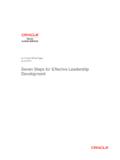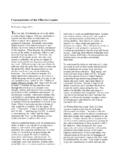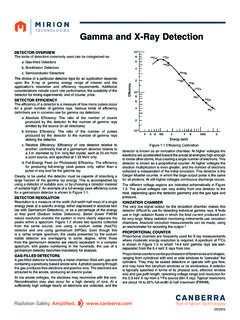Transcription of Business Life Cycles and Five Elements Theory
1 Business life Cycles and five Elements Theory Kuang-cheng Wang Doctoral Program, Graduate Institute of Business Administration, National Taipei University, Taipei, Taiwan, E-mail: ABSTRACT. This paper proposes a five -stage life cycle model to describe Business development from birth to death with the five Elements Theory . A five -stage model, including birth, survival, success, decline, and renewal, is developed in terms of interactions of Business functions, which are classified into the Chinese five Elements . Each stage of the Business life cycle could be characterized by the different combinations of the Water-Fire, Fire-Metal, and Earth-Water effects.
2 The Water-Fire effect marks the beginning and direction of Business development, the Fire-Metal effect indicates a firm's competitiveness in the industry, and the Earth-Water effect signifies its capabilities of organizational learning and innovation. The Business life cycle could be more clearly understood and explained by means of these three effects. At the birth stage, firms create a profitable and sustainable vision (a new Water-Fire effect). As firms move into the survival stage, they seek to grow by developing their learning capacities (the Earth-Water effect) and increasing their competitiveness in cost.
3 The success stage could be illustrated mainly by the strong Fire-Metal effect, which is manifested by the increasing profit and competitiveness. The decline stage is characterized by deteriorating profits and a loss of market share (the weak Fire-Metal effect) and by lack of learning capabilities. The renewing firms have to rebuild their learning and innovative capabilities (the Earth-Water effect) and shape a new profitable direction for Business . The contribution of this research lies in the attempt to link interactions of Business functions and Business life Cycles . It provides a tool to diagnose holistically problems of Business development in the new economy.
4 Keywords: Business life Cycles ; five Elements Theory ; Business functions, Chinese systems thinking 1. INTRODUCTION. Numerous researches have focused on the life Cycles of organizational development ( Chandler, 1962; Greiner, 1972; Quinn & Cameron, 1983, Hanks, Watson, Jensen & Chandler, 1993; Lester, Parnell & Carraher, 2003). However, there is very literature that has attempted to explain or predict the life cycle from the perspective of systems thinking. This study features the application of Chinese five Elements Theory to the Business life Cycles . Three types of interactions of Business functions in terms of the Chinese five Elements will be introduced to mark out the characteristics of different stages in Business life Cycles .
5 Moreover, this research will demonstrate how different stages are interrelated to each other. Finally, the process of the corporate change has been identified as the renewal stage in Business life Cycles and illustrated in terms of interactions of Business functions. This study aims at the search for the Business life cycle in the new economy. Kolter (2003, p. 36-37) argued that the old economy was concerned with manufacturing firms whose main driver was to standardize production, products, and Business processes. By contrast, the new economy, backed up by information Business , utilizes information to differentiate, customize, personalize, and dispatch over networks at an incredible speed.
6 It is obvious that old economy focused mainly on how to produce goods efficiently while the new economy highlights the significance of the innovation and marketing functions in Business . Therefore, this research has attempted to reveal the relationships between the Business functions and its life cycle in the new economy. Business life Cycles . Literature review Adapting the concept from the biological sciences, a number of researchers has proposed life Cycles of organizational development from birth to death ( Chandler, 1962; Greiner, 1972; Galbraith, 1982; Churchill, 1983; Quinn & Cameron, 1983;. Miller & Friesen, 1980, 1984; Smith, Mitchell & Summer, 1985; Dodge & Robbins, 1992; Hanks, Watson, Jensen & Chandler, 1993; Kazanjian, 1988; Beverland &.)
7 Lockshin, 2001; Lester, Parnell & Carraher, 2003) As one of the earlier contributors, Chandler (1962) introduced stages to a life cycle model in which he argued that as stages changed, so did firms' strategies and structures and had identified a four-stage model of organization evolution. As to the nature of stages, most authors appear to follow the idea of Chandler's (1962) landmark work, Strategy and Structure that organizations develop patterns of organization structure in response to common growth and market challenges. A valid life - cycle model could provide a road map for managers to identify critical organizational changes and problems as organizations grow and develop (Hanks et al.
8 , 1993; Beverland & Lockshin, 2001). Hanks, Watson, Jensen & Chandler (1993) defined life cycle stages as a unique configuration of variables related to organization context and structure. In their definition, common contextual dimensions are comprised of organization age, size, growth rate, and focal tasks or challenges faced by the firm while common structural dimensions including structural form, formalization, centralization, and vertical differentiations, the number of organizations levels. Through how many life - cycle stages do organizations grow? Most of the existing organizational life - cycle models are multi-stage in nature, varying broadly from three (Smith, Mitchell, and Summer, 1985) to ten (Adizes, 1989) stages.
9 Hanks, Watson, 2. Jensen & Chandler (1993) had presented a good summary of existing life models, noting that a comparison of stage content reveals a fairly consistent pattern of organization evolution. Miller and Friesen (1984) contended that organizations tend to move in a linear sequence of five stages: birth, growth, maturity, revival, and decline. They, however, argued that organizations by no means go through the stage in the same sequence. Lester, Parnell & Carraher (2003) found that models with more stages appear to break down general stages to rather specific periods. By contrast, model with fewer, broader stages integrate two or more developmental periods because of parsimony.
10 The Business life - cycle model in this study aims to be designed for for-profit firms in the new economy rather than relevant for all organizations. Most of the organizational life cycle researches are not designed for not-for-profit organizations. However, the term organizational life Cycles should include the life Cycles of not-for-profit organizations. There is no existing research trying to answer questions about the differences of life Cycles between for-profit and not-for-profit organizations. Therefore, the author uses Business life Cycles to define the scope of organizational developmental process.







